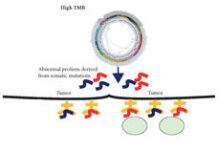COLUMBUS consists of two parts: part 1 compared encorafenib 450 mg once daily plus binimetinib 45 mg twice a day (COMBO450), encorafenib 300 mg once daily (ENCO300), and 960 mg vemurafenib arms, and part 2 compared encorafenib 300 mg once daily plus binimetinib 45 mg twice daily (COMBO300) and ENCO300 arms. Results from part 1 demonstrated that COMBO450 improved progression-free survival (PFS) versus vemurafenib, leading to approval of this dosage in countries globally for the treatment of patients with BRAFV600-mutated unresectable or metastatic melanoma. PFS was also improved for COMBO450 versus ENCO300 but was not statistically significant. Favourable safety and tolerability were observed for COMBO450 versus vemurafenib and versus ENCO300 monotherapy.
In part 2, the efficacy, safety, and tolerability of COMBO300 were improved compared with ENCO300. Together with part 1 results, these data confirm and extend the evidence for the contribution of binimetinib for the treatment of BRAF-mutated, advanced, unresectable melanoma. The findings are reported by Dr. Paolo A. Ascierto of the Melanoma Unit, Cancer Immunotherapy and Innovative Therapies, Istituto Nazionale Tumori IRCCS Fondazione Pascale in Naples, Italy, and colleagues on 28 July 2023 in the JCO.
The purpose of the part 2, which resulted from a study amendment requested by the US Food and Drug Administration, was to delineate the contribution of binimetinib to the efficacy and safety of encorafenib plus binimetinib combination therapy by keeping the same dosage of encorafenib in both study arms.
The authors wrote in the background that activating BRAFV600 mutations occur in approximately 50% of patients with melanoma. Mutations drive constitutive activation of the MAPK pathway, resulting in melanoma development and progression. Dual inhibition of the MAPK pathway with BRAF/MEK inhibitor combination therapy is a standard treatment in patients with BRAFV600-mutated metastatic melanoma and has demonstrated improved PFS and overall survival (OS) with manageable tolerability compared with BRAF inhibition monotherapy.
COLUMBUS is a two-part, randomised, active-controlled, phase III study evaluating the BRAF/MEK inhibitor combination of encorafenib plus binimetinib. In part 1 of COLUMBUS, 577 eligible patients with unresectable or metastatic melanoma with a BRAFV600 mutation were randomly assigned to COMBO450 (192 patients), ENCO300 (194 patients), or vemurafenib 960 mg twice a day (191 patients). The part 1 primary endpoint was PFS in the COMBO450 versus vemurafenib groups as assessed by blinded independent central review (BICR), and the part 1 key secondary endpoint was PFS in the COMBO450 versus ENCO300 groups.
The COMBO450 improved PFS compared with vemurafenib, leading to approval of this dosage globally for the treatment of patients with BRAFV600-mutated unresectable or metastatic melanoma. PFS was improved for COMBO450 versus ENCO300 but was not statistically significant (p = 0.051). Favourable safety and tolerability were observed for COMBO450 versus vemurafenib and versus ENCO300 monotherapy.
To isolate the contribution of binimetinib to combination therapy, COLUMBUS part 2 was designed with the same dosage of encorafenib in the combination and comparator arms: ENCO300 plus binimetinib 45 mg twice a day (COMBO300) versus ENCO300. In part 2, patients were randomly assigned 3:1 to COMBO300 or ENCO300. ENCO300 (parts 1 and 2) data were combined, per protocol, for PFS analysis (key secondary endpoint) by BIRC. Other analyses included overall response rate (ORR), OS, and safety.
A total, 258 patients received COMBO300, and 86 received ENCO300. Per protocol, ENCO300 arms (parts 1 and 2 combined) were also evaluated (280 patients). The median follow-up for ENCO300 was 40.8 months (part 1) and 57.1 months (part 2). The median PFS (95% confidence interval [CI]) was 12.9 months (10.9 to 14.9) for COMBO300 versus 9.2 months (7.4 to 11.1) for ENCO300 (parts 1 and 2) and 7.4 months (5.6 to 9.2) for ENCO300 (part 2). The hazard ratio (95% CI) for COMBO300 was 0.74 (0.60 to 0.92; two-sided p = 0.003) versus ENCO300 (parts 1 and 2).
The ORR by BIRC (95% CI) was 68% (62 to 74) and 51% (45 to 57) for COMBO300 and ENCO300 (parts 1 and 2), respectively. COMBO300 had greater relative dose intensity and fewer grade 3/4 adverse events than ENCO300.
The authors concluded that the efficacy, safety, and tolerability of COMBO300 were improved compared with ENCO300. These results suggest that maximising BRAF inhibition in BRAF/MEK inhibitor combinations improves efficacy and that COMBO450, the approved dosage, should be used based on available evidence from COLUMBUS.
In an accompanied editorial article, Dr. Ryan J. Sullivan of the Massachusetts General Hospital Cancer Center in Boston, MA, US wrote that part 2 of the COLUMBUS study has reinforced that MEK inhibition is critical for the efficacy and safety of BRAF inhibition in patients with advanced BRAFV600-mutated melanoma. However, several questions remain to be answered as the treatment landscape has shifted over the past half decade. One important challenge is that all the major studies of BRAF targeted therapy have been in frontline setting and thus it is more difficult to understand the exact benefit of subsequent line BRAF targeted therapy.
The DREAMSeq study investigated the sequence of immune checkpoint inhibition, with the combination of ipilimumab and nivolumab, and BRAF targeted therapy, with dabrafenib and trametinib, and definitively concluded that the optimal frontline therapy for most patients with newly diagnosed, advanced BRAFV600-mutated melanoma is immune checkpoint inhibitor therapy. Thus, at this point, the data support the use of combined BRAF/MEK inhibition in second or later lines of therapy for advanced melanoma, but most patients progress within months if therapy is preceded by PD1 or PD-L1 therapy, and BRAF targeted therapy appears to be more toxic if started within 6-12 weeks of last dose of immune checkpoint inhibition. Therefore, the optimal role of BRAF targeted therapy in patients with advanced melanoma is not well defined, and more effective BRAF targeted therapy regimens are needed.
Besides the question on when should BRAF targeted therapy be used, the following questions are also challenging: What effect does adjuvant therapy play on optimal timing of BRAF targeted therapy use? Can triplet or quadruplet regimens improve upon the efficacy of combined BRAF/MEK inhibition without prohibitive toxicity?
The study was previously presented in part at the ESMO 2021 Virtual Congress (16-21 September 2021).
The study was supported by Novartis in collaboration with Array BioPharma. Array BioPharma was acquired by Pfizer in July 2019.








